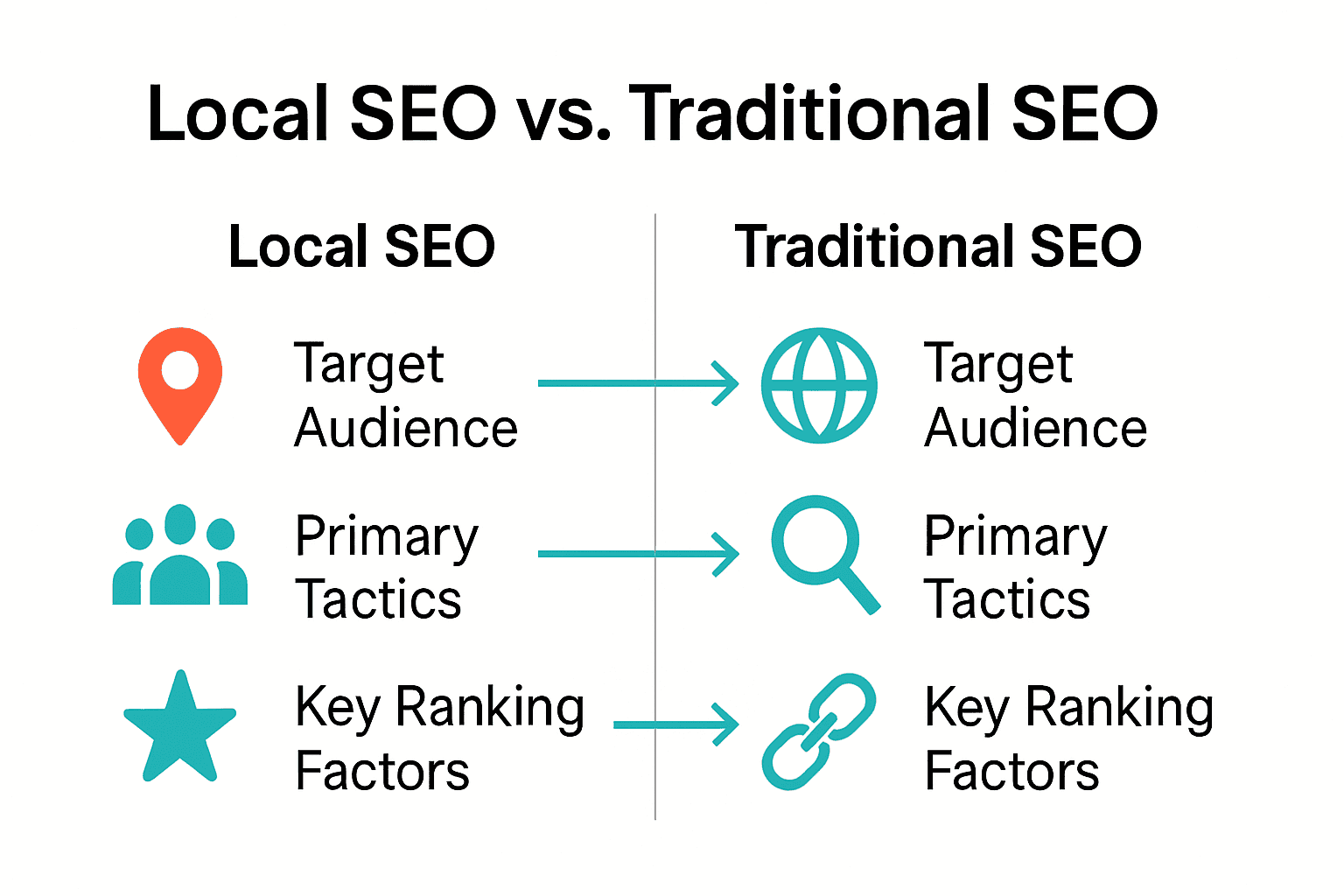Did you know that over 46 percent of all Google searches have local intent? When someone looks for a nearby service or store, the results they see are no accident. Local SEO shapes which businesses appear at the top, making it a make-or-break factor for reaching real customers in your area. Knowing how local SEO works, and sorting out the facts from common myths, can help any business stand out and attract more local leads.
Table of Contents
- Defining Local SEO And Common Myths
- How Local SEO Differs From Traditional SEO
- Key Ranking Factors And Algorithms
- Essential Local SEO Strategies For Businesses
- Common Pitfalls And How To Avoid Them
Key Takeaways
| Point | Details |
|---|---|
| Local SEO Importance | Local SEO is essential for businesses of all sizes, enhancing visibility for local customer searches. |
| Myth Debunking | Important myths include the misconception that local SEO is only relevant for large businesses or that it works instantly. |
| Focus on Key Strategies | Essential strategies include optimizing Google Business Profiles, ensuring consistent NAP information, and creating location-specific content. |
| Avoid Common Pitfalls | Common mistakes such as inconsistent NAP information and neglecting customer reviews can severely impact local search visibility. |
Defining Local SEO and Common Myths
Local SEO represents a strategic digital marketing approach designed specifically for businesses targeting customers within a specific geographic region. According to Wikipedia, local SEO focuses on optimizing a business’s online presence to appear prominently in search results for localized queries, dramatically enhancing visibility for users seeking nearby products or services.
Understanding local SEO requires debunking several persistent myths that can mislead small business owners. Many entrepreneurs mistakenly believe local SEO is only relevant for massive corporations or brick-and-mortar retail establishments. In reality, local SEO is crucial for businesses of all sizes – from solo contractors and home service providers to medical practices and neighborhood restaurants. The goal is simple: make your business discoverable when potential customers search for services “near me” or within your specific community.
Some common myths about local SEO include:
-
Myth: Local SEO is just about Google My Business
Reality: While Google My Business is important, true local SEO involves a comprehensive strategy including website optimization, local content creation, citation building, and review management. -
Myth: Local SEO works instantly
Reality: Building local search authority takes time, consistent effort, and strategic implementation across multiple digital platforms. -
Myth: Local SEO is too complicated for small businesses
Reality: With the right approach and resources, any business can improve its local search visibility. You don’t need a massive marketing budget – just targeted, smart tactics.
To maximize your local SEO potential, businesses must focus on creating a robust online presence that signals relevance, proximity, and credibility to search engines. This means maintaining accurate business information across platforms, generating authentic customer reviews, producing locally-relevant content, and ensuring your website is technically optimized for local search queries.
By understanding these fundamental principles, small business owners can transform their digital marketing strategy and connect more effectively with their local customer base. Understanding the Benefits of Local SEO for Small Businesses provides deeper insights into developing a winning local search strategy.

How Local SEO Differs From Traditional SEO
Local SEO and traditional SEO might seem similar on the surface, but they represent distinctly different strategies for improving online visibility. According to Search Engine Land, local SEO targets specific geographic areas, optimizing for location-based keywords and local listings, whereas traditional SEO aims for broader, often national or global visibility.
The fundamental difference lies in the intent and approach. Traditional SEO focuses on ranking for broad, often competitive keywords across wide geographical regions. Local SEO, by contrast, narrows the focus to capture potential customers within a specific community or service area. This means a plumber in Atlanta isn’t just competing with all plumbing websites, but specifically with other local plumbing services in the metropolitan area.
Key distinctions between local and traditional SEO include:
-
Geographic Targeting
Local SEO prioritizes proximity and location-specific signals, while traditional SEO emphasizes broader content relevance and domain authority. -
Search Intent
Local searches typically have immediate, transactional intent (“emergency plumber near me”), whereas traditional SEO often targets informational or research-oriented queries. -
Ranking Factors
As Rocks Digital explains, local SEO emphasizes factors like Google Business Profile optimization and local citations, while traditional SEO focuses more on content quality and backlink profiles.
For small businesses, understanding these nuances is crucial. Local SEO allows you to compete effectively in your immediate market, leveraging location-specific strategies that traditional SEO approaches might overlook.
This means optimizing your Google Business Profile, gathering local reviews, creating location-specific content, and ensuring your business appears in local directory listings.
Here’s a summary comparing Local SEO and Traditional SEO:

| Aspect | Local SEO | Traditional SEO |
|---|---|---|
| Geographic Focus | Specific regions Neighborhoods |
National or global |
| Target Audience | Local customers | Broad or international |
| Primary Tactics | Google Business Profile Local citations |
Content quality Backlinking |
| Search Intent | “Near me” Transactional |
Research Informational |
| Ranking Factors | Proximity Relevance Prominence |
Authority Content Links |
| Content Strategy | Location-specific Community-based |
General Industry-focused |
Local SEO Strategies for Small Business Success can help you dive deeper into implementing these targeted marketing techniques that can transform how potential customers discover your business.
Key Ranking Factors and Algorithms
Local SEO ranking is a complex ecosystem of interconnected signals that search engines use to determine the most relevant local businesses for a specific search query. According to Search Engine Land, local SEO ranking factors fundamentally revolve around three critical dimensions: proximity, relevance, and prominence, with algorithms carefully analyzing location-specific signals to deliver the most accurate search results.
Proximity represents perhaps the most direct ranking factor. When a potential customer searches for a service “near me,” search engines prioritize businesses geographically closest to the searcher’s location. However, proximity isn’t the only consideration. Relevance plays an equally crucial role, examining how well a business matches the specific search intent and query details.
Key ranking factors for local businesses include:
-
NAP Consistency
Name, Address, Phone Number (NAP) must be identical across all online platforms and directories. Inconsistent information can significantly harm local search rankings. -
Google Business Profile Optimization
A completely filled-out, verified Google Business Profile with accurate information, regular updates, and authentic customer photos can dramatically improve local visibility. -
Local Citations
As Rocks Digital explains, local citations – mentions of your business across various online platforms – serve as critical trust signals for search algorithms. -
Customer Reviews
Quantity and quality of customer reviews directly impact local search rankings. More positive, verified reviews signal business credibility and trustworthiness. -
Website Localization
Including location-specific keywords, creating local content, and embedding a Google Map on your website can enhance local search performance.
Understanding these algorithms isn’t just about technical optimization – it’s about creating a genuine, trustworthy online presence that resonates with both search engines and potential customers. The most successful local businesses view SEO as an opportunity to showcase their authentic local identity and community connections.
Understanding Local SEO Ranking Factors for Businesses offers deeper insights into navigating these complex digital marketing strategies that can transform your local business’s online visibility.
Essential Local SEO Strategies for Businesses
Local SEO isn’t just a marketing tactic – it’s a critical lifeline for businesses seeking to connect with nearby customers. According to Search Engine Land, effective local SEO strategies involve a comprehensive approach that goes far beyond simple website optimization, encompassing multiple digital touchpoints that signal your business’s local relevance and credibility.
At the core of successful local SEO lies strategic digital positioning. This means creating a holistic online presence that tells search engines and potential customers exactly who you are, what you do, and where you’re located. Consistency is key – every online mention of your business should reinforce your core identity, from your Google Business Profile to local directory listings.
Crucial local SEO strategies include:
-
Google Business Profile Optimization
Complete every section of your profile, add high-quality photos, respond to reviews, and keep information updated in real-time. -
NAP Consistency
Ensure your Name, Address, and Phone Number are identical across all online platforms. Even minor variations can confuse search algorithms. -
Local Content Creation
Develop content that speaks directly to your local community, highlighting local events, addressing local challenges, and showcasing community involvement. -
Review Management
As Rocks Digital explains, actively managing and responding to customer reviews demonstrates engagement and builds trust with both customers and search engines. -
Local Link Building
Cultivate relationships with local businesses, chambers of commerce, and community organizations to generate authentic, location-specific backlinks.
Successful local SEO is about more than technical optimization – it’s about telling your business’s unique local story. By demonstrating genuine community connection and providing value to local customers, you transform SEO from a mechanical process into a powerful relationship-building tool.
How to Get Found Locally: Proven Strategies for 2025 provides an in-depth roadmap for businesses looking to master their local digital presence and stand out in an increasingly competitive marketplace.
Common Pitfalls and How to Avoid Them
Local SEO can be a minefield of potential mistakes that can dramatically undermine a business’s online visibility. According to Search Engine Land, common local SEO pitfalls often stem from seemingly minor oversights that can have significant consequences for a business’s digital marketing efforts.
The most critical errors frequently occur in areas businesses might consider trivial. Inconsistent business information across online platforms can confuse both potential customers and search engine algorithms. Something as simple as a slight variation in your business name, address, or phone number across different directories can create trust signals that actually harm your local search rankings.
Most common local SEO pitfalls include:
-
Inconsistent NAP Information
Name, Address, and Phone Number must be 100% identical across all online platforms. Even minor variations can tank your local search credibility. -
Neglecting Google Business Profile
An incomplete or outdated Google Business Profile is like having a storefront with the lights off. It signals to potential customers and search engines that you’re not actively managing your online presence. -
Ignoring Customer Reviews
As Rocks Digital explains, failing to manage and respond to customer reviews can significantly damage your local search reputation. Every review is an opportunity to demonstrate customer care. -
Poor Mobile Optimization
With most local searches happening on mobile devices, a non-responsive website is essentially invisible to potential customers. -
Lack of Local Content
Generic content won’t cut it. Local businesses need hyper-local, geographically specific content that speaks directly to their community.
Understanding these pitfalls is just the first step. The real magic happens when businesses transform these potential landmines into opportunities for connection and trust-building. Each challenge is a chance to differentiate yourself from competitors who aren’t paying attention.
Digital Marketing Basics for Small Businesses in 2025 can provide additional insights into navigating the complex world of local digital marketing and turning potential obstacles into strategic advantages.
Elevate Your Local Presence with Expert Help from Ibrandmedia
Facing challenges with local SEO like inconsistent business listings or struggling to stand out in your community search results can feel overwhelming. This article highlights key pain points such as managing your Google Business Profile, generating authentic customer reviews, and ensuring NAP consistency. These are crucial steps that determine your visibility but require specialized attention and a proven strategy to get right.
If you want to turn these challenges into growth opportunities now is the time to take action. Explore effective local SEO and digital marketing solutions tailored for small businesses at Uncategorized | Ibrandmedia.

Discover how our services at ibrand.media provide affordable, targeted tactics including SEO optimization, local content creation, and review management designed to boost your local rankings quickly and reliably. Don’t wait until you lose potential customers to the competition. Visit Uncategorized | Ibrandmedia to start your personalized campaign today and watch your local business get found by more people in your community.
Frequently Asked Questions
What is local SEO?
Local SEO is a specialized approach to digital marketing that helps businesses optimize their online presence to appear prominently in search results for localized queries. It focuses on attracting customers in specific geographic areas by improving visibility in search engine results.
How does local SEO differ from traditional SEO?
Local SEO targets specific geographic areas and focuses on location-based keywords, while traditional SEO aims for broader visibility across national or global spheres. Local SEO emphasizes proximity and relevance, whereas traditional SEO centers on content quality and domain authority.
What are the key ranking factors for local SEO?
Key ranking factors for local SEO include NAP consistency (Name, Address, Phone Number), Google Business Profile optimization, local citations, customer reviews, and website localization. These factors help search engines determine the most relevant local businesses for specific queries.
How can businesses improve their local SEO?
Businesses can improve their local SEO by optimizing their Google Business Profile, ensuring NAP consistency across online platforms, creating locally relevant content, actively managing customer reviews, and building local backlinks. Consistency and community engagement are essential for boosting local search visibility.
Recommended
- Top SEO Techniques for Small Business Owners in 2025 | Ibrandmedia
- Understanding the Benefits of Local SEO for Small Businesses | Ibrandmedia
- Understanding Local SEO Ranking Factors for Businesses | Ibrandmedia
- Local SEO Strategies for Small Business Success | Ibrandmedia
- SEO Basics: Everything You Need to Know

Recent Comments